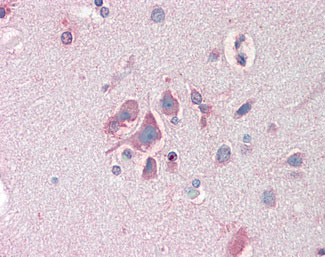FBXL2 Antibody (N-Terminus)
Goat Polyclonal Antibody
- SPECIFICATION
- CITATIONS
- PROTOCOLS
- BACKGROUND

Application
| WB, IHC-P, E |
|---|---|
| Primary Accession | Q9UKC9 |
| Reactivity | Human, Horse, Bovine, Dog |
| Host | Goat |
| Clonality | Polyclonal |
| Calculated MW | 47kDa |
| Dilution | ELISA (1:32000), IHC-P (10 µg/ml), WB (1:32000) |
| Gene ID | 25827 |
|---|---|
| Other Names | F-box/LRR-repeat protein 2, F-box and leucine-rich repeat protein 2 {ECO:0000312|HGNC:HGNC:13598}, F-box protein FBL2/FBL3 {ECO:0000303|PubMed:10945468, ECO:0000312|EMBL:AAF04510.1}, FBXL2 (HGNC:13598) |
| Target/Specificity | Human FBXL2. |
| Reconstitution & Storage | Store at -20°C. Minimize freezing and thawing. |
| Precautions | FBXL2 Antibody (N-Terminus) is for research use only and not for use in diagnostic or therapeutic procedures. |
| Name | FBXL2 {ECO:0000303|PubMed:22323446, ECO:0000312|HGNC:HGNC:13598} |
|---|---|
| Function | Calcium-activated substrate recognition component of the SCF (SKP1-cullin-F-box protein) E3 ubiquitin-protein ligase complex, SCF(FBXL2), which mediates the ubiquitination and subsequent proteasomal degradation of target proteins (PubMed:22020328, PubMed:22323446). Unlike many F-box proteins, FBXL2 does not seem to target phosphodegron within its substrates but rather calmodulin- binding motifs and is thereby antagonized by calmodulin (PubMed:22020328, PubMed:22323446). This is the case for the cyclins CCND2 and CCND3 which polyubiquitination and subsequent degradation are inhibited by calmodulin (PubMed:22020328, PubMed:22323446). Through CCND2 and CCND3 degradation induces cell-cycle arrest in G(0) (PubMed:22020328, PubMed:22323446). SCF(FBXL2) also mediates PIK3R2 ubiquitination and proteasomal degradation thereby regulating phosphatidylinositol 3-kinase signaling and autophagy (PubMed:23604317). PCYT1A monoubiquitination by SCF(FBXL2) and subsequent degradation regulates synthesis of phosphatidylcholine, which is utilized for formation of membranes and of pulmonary surfactant (By similarity). The SCF(FBXL2) complex acts as a regulator of inflammation by mediating ubiquitination and degradation of TRAF proteins (TRAF1, TRAF2, TRAF3, TRAF4, TRAF5 and TRAF6) (By similarity). The SCF(FBXL2) complex acts as a negative regulator of the NLRP3 inflammasome by mediating ubiquitination and degradation of NLRP3 (PubMed:26037928). |
| Cellular Location | Membrane; Lipid- anchor |
| Tissue Location | Expressed in brain, heart, kidney, liver, lung, pancreas and placenta. |

Thousands of laboratories across the world have published research that depended on the performance of antibodies from Abcepta to advance their research. Check out links to articles that cite our products in major peer-reviewed journals, organized by research category.
info@abcepta.com, and receive a free "I Love Antibodies" mug.
Provided below are standard protocols that you may find useful for product applications.
Background
Calcium-activated substrate recognition component of the SCF (SKP1-cullin-F-box protein) E3 ubiquitin-protein ligase complex, SCF(FBXL2), which mediates the ubiquitination and subsequent proteasomal degradation of target proteins. Unlike many F-box proteins, FBXL2 does not seem to target phosphodegron within its substrates but rather calmodulin-binding motifs and is thereby antagonized by calmodulin. This is the case for the cyclins CCND2 and CCND3 which polyubiquitination and subsequent degradation are inhibited by calmodulin. Through CCND2 and CCND3 degradation may induce cell-cycle arrest in G(0). SCF(FBXL2) may also mediate PIK3R2 ubiquitination and proteasomal degradation thereby regulating phosphatidylinositol 3-kinase signaling and indirectly autophagy (PubMed:22323446, PubMed:22020328, PubMed:23604317). PCYT1A monoubiquitination by SCF(FBXL2) and subsequent degradation may regulate synthesis of phosphatidylcholine, which is utilized for formation of membranes and of pulmonary surfactant (By similarity).
References
Cenciarelli C.,et al.Curr. Biol. 9:1177-1179(1999).
Winston J.T.,et al.Curr. Biol. 9:1180-1182(1999).
Ilyin G.P.,et al.Genomics 67:40-47(2000).
Ota T.,et al.Nat. Genet. 36:40-45(2004).
Ebert L.,et al.Submitted (JUN-2004) to the EMBL/GenBank/DDBJ databases.
If you have used an Abcepta product and would like to share how it has performed, please click on the "Submit Review" button and provide the requested information. Our staff will examine and post your review and contact you if needed.
If you have any additional inquiries please email technical services at tech@abcepta.com.













 Foundational characteristics of cancer include proliferation, angiogenesis, migration, evasion of apoptosis, and cellular immortality. Find key markers for these cellular processes and antibodies to detect them.
Foundational characteristics of cancer include proliferation, angiogenesis, migration, evasion of apoptosis, and cellular immortality. Find key markers for these cellular processes and antibodies to detect them. The SUMOplot™ Analysis Program predicts and scores sumoylation sites in your protein. SUMOylation is a post-translational modification involved in various cellular processes, such as nuclear-cytosolic transport, transcriptional regulation, apoptosis, protein stability, response to stress, and progression through the cell cycle.
The SUMOplot™ Analysis Program predicts and scores sumoylation sites in your protein. SUMOylation is a post-translational modification involved in various cellular processes, such as nuclear-cytosolic transport, transcriptional regulation, apoptosis, protein stability, response to stress, and progression through the cell cycle. The Autophagy Receptor Motif Plotter predicts and scores autophagy receptor binding sites in your protein. Identifying proteins connected to this pathway is critical to understanding the role of autophagy in physiological as well as pathological processes such as development, differentiation, neurodegenerative diseases, stress, infection, and cancer.
The Autophagy Receptor Motif Plotter predicts and scores autophagy receptor binding sites in your protein. Identifying proteins connected to this pathway is critical to understanding the role of autophagy in physiological as well as pathological processes such as development, differentiation, neurodegenerative diseases, stress, infection, and cancer.



